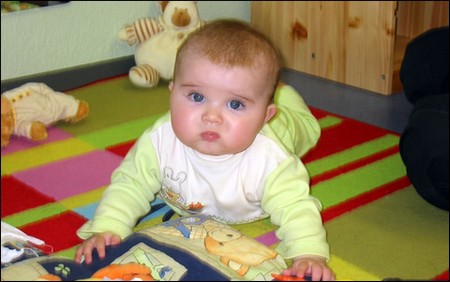Although it is not common, childhood diabetes is increasingly seen in children under age five. They require very small amounts of insulin, which of course parents must inject, usually in a diluted solution of U-100 regular insulin. A diabetes educator will show you how to prepare it.
Because the disease is so unusual in young children, it may not be diagnosed until your child is very ill with dehydration and fever. Hospitalization for a few days might be necessary while the disease is stabilized.

After discharge, the child may be thin and cranky and have a poor appetite. Insulin injections, blood tests, and other procedures will increase the moodiness. But once the disease is stabilized, and this happens very quickly, full appetite and sunny disposition return. Caring for an infant or toddler with diabetes is not as difficult as you might imagine.
A baby or toddler’s urine is easy to test for glucose by squeezing a few drops from a diaper onto a test strip. (It is best not to test a baby’s blood glucose except when absolutely necessary to avoid the repeated trauma of skin pricks.) Urine testing for glucose is not as accurate as blood testing, but it can give you a warning sign that all is not well. Often, the first sign of illness in an infant or toddler is elevated glucose. You should probably test your baby’s urine several times a day for glucose (use a disposable diaper to avoid confounding the results with detergents).
When your child is first diagnosed, the doctor will suggest that you test for ketones several times a day; when the baby’s diabetes is stabilized, once a week is usually often enough. If you need to test an infant or toddler’s blood, use an earlobe rather than a finger. It is less traumatic and easier to get a drop of blood. Make sure the lobe is warm. Right after a hat is removed is a good time, or you might want to make a game of it by placing your hand over the child’s ears and cooing or doing something else silly and fun.
One thing you should be aware of: An infant or toddler is too young to recognize the warning signs of hyper- or hypoglycemia, so you need to commit the symptoms to memory and be especially watchful. Toddlers are at a stage where they try to exert their independence, and if they don’t feel like eating, they’ll do just about anything to avoid it, including spitting out whatever you put in their mouths. Depending on their activity level, this might pose a problem. A flexible eating schedule can avoid food battles and reduces the risk of hypoglycemia. In addition, parents need to learn the difference between age-appropriate contrariness and other normal toddler behavior, and insulin reactions.
If a young child has an insulin reaction and is unconscious or won’t take sugar by mouth, inject 1/2 cc of glucagon into the buttocks until the child is alert enough to take food by mouth. If there is no response in fifteen minutes, give another 1 /2 cc and call the doctor.
Regarding babysitters, if you go out for an evening, it’s probably unlikely that you will have to entrust a sitter with either blood glucose testing or insulin injections. But all babysitters should know the warning signs of hyper- and hypoglycemia and what actions to take, as well as what to do in the event of a diabetic emergency.
When hiring a babysitter, look for a responsible adult, not the thirteen-year-old down the street—unless it’s a mature teenager with diabetes. They know what to look for and will be especially observant. It will give a teenager a boost in pride to think that parents of a diabetic baby have enough faith in their maturity to take responsibility for their child.
You should list all the signs and the actions to take for each and place it in a prominent place: near phones in the kitchen and family room or on the refrigerator—wherever your family’s message center is located. The telephone number of your child’s physician should be at the top of the list. In addition, you need to make certain that the babysitter knows where you will be at all times. Some parents carry a beeper, but this may be excessive.
It’s a good idea for the babysitter to know how to give an insulin injection (you may time your evening out for between injections, but things happen and you might not be able to get home in time). Leave snacks for the baby with clearly written instructions of when and how they are to be given to the child. One way to solve the problem of having to teach a stranger all these things is to arrange a babysitting pool with other parents of diabetic children.
If both parents work outside the home, day care can be a problem. Most day care centers are not equipped to handle diabetic children; in fact, most won’t take a child with any type of illness. So your options are limited. The best solution is again a pool of parents, but if you live in a small town, there probably won’t be enough people.
Following are a few general pieces of information that might prove useful when caring for a little one with diabetes:
- When your baby cries or seems unusually fretful, the only way to know the difference between hypoglycemia and something else is to test blood glucose. If you are in a place where you absolutely cannot monitor blood glucose (or if you have forgotten to bring the monitor with you), give the baby some juice or a sugary snack. It is better to err on the side of too high than too low blood glucose.
- The best insulin syringes for babies are low-dose disposables that measure only up to fifty units and use U-100 insulin.
- Rotate injection sites to avoid lumps and depressions under the skin. Keep insulin at room temperature to make injections more comfortable
- Both parents (and siblings if they are old enough) should give insulin injections so the baby does not see only one person as diabetes caretaker.

- Infants and toddlers must eat relatively soon after an injection, even if they don’t want to. Think about devising creative ways to get your child to eat. Small snacks are probably better than large, regular meals so keep hard boiled eggs, fruit, and crackers on hand.
- If babies vomit after injections, they must eat something with enough carbohydrates to prevent an insulin reaction that won’t upset their stomach. Regular soda or Popsicles are good.
- Read the label of commercial baby foods; most have added sugar. Many parents prefer to make their own baby food in a blender or food processor. Try freezing it in an ice cube tray that is separated into individual cubes; you can warm up the amount you need in the microwave and save the rest of the tray for another time.
- When you travel with your child, even if it’s only a quick run to the supermarket, always have snacks, a bottle of insulin, and injection equipment with you.